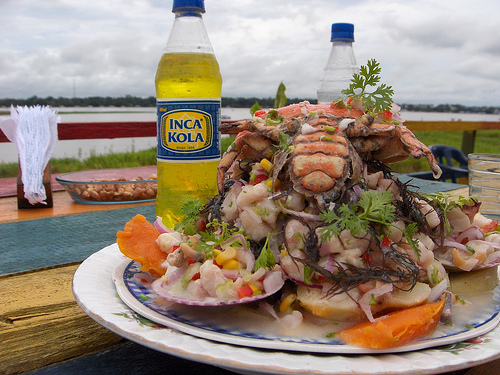When learning Spanish abroad, try to get out of your comfort zone whenever possible. After all, for many students, living and studying abroad will be a once in a lifetime experience. You should definitely try to absorb as much local culture as possible. That means speaking only Spanish and dining on only traditional Peruvian cuisine. Here are some key dishes to try:
Cuy – Cuy, or guinea pig, is a traditional Andean meat. If you’re squeamish about cuy, try to find a place that serves the meat as cutlets, rather than in the traditional way, which is fried or roasted whole.
Ceviche – The Peruvian version of sushi, ceviche is a citrus-marinated raw fish salad.
Anticuchos – This is essentially a kebab marinated in garlic sauce. For the most traditional anticucho eating experience, try to find ones made with beef hearts. Imagine you are an Incan royal dining on the choicest cut of meat as you eat these.
Alpaca jerky – In the highlands of Peru, alpacas are raised not only for wool but also for meat. This gamey meat makes great jerky.
Causa – Peru is famous for its hundreds of varieties of potatoes. You can sample some in this dish, which is made of layers of potato and avacado and served cold.
Aji de Gallina – This is Peru’s version of Mom’s chicken soup. It’s very rich because it’s made with condensed milk, and yellow peppers give it a little kick.
Lucuma – This local fruit has a custardy texture and a taste similar to maple syrup. If you can’t find fresh lucuma, try lucuma ice cream.
Mazamorra Morada – This popular desert is made from Peruvian blue corn, plus various fruits and spices like cinnamon and cloves. It’s kind of like a rice pudding, only made with corn.
Inca Kola – This soda isn’t anything like a cola. It’s actually very sweet, with a taste some people describe as like bubble gum or candy.
Pisco – This grape brandy is very traditional for Chile and Peru, and the two countries each want to claim it as their national drink.
When learning Spanish abroad, try to get out of your comfort zone whenever possible. After all, for many students, living and studying abroad will be a once in a lifetime experience. You should definitely try to absorb as much local culture as possible. That means speaking only Spanish and dining on only traditional Peruvian cuisine. Here are some key dishes to try:
Cuy – Cuy, or guinea pig, is a traditional Andean meat. If you’re squeamish about cuy, try to find a place that serves the meat as cutlets, rather than in the traditional way, which is fried or roasted whole.
Ceviche – The Peruvian version of sushi, ceviche is a citrus-marinated raw fish salad.
Anticuchos – This is essentially a kebab marinated in garlic sauce. For the most traditional anticucho eating experience, try to find ones made with beef hearts. Imagine you are an Incan royal dining on the choicest cut of meat as you eat these.
Alpaca jerky – In the highlands of Peru, alpacas are raised not only for wool but also for meat. This gamey meat makes great jerky.
Causa – Peru is famous for its hundreds of varieties of potatoes. You can sample some in this dish, which is made of layers of potato and avacado and served cold.
Aji de Gallina – This is Peru’s version of Mom’s chicken soup. It’s very rich because it’s made with condensed milk, and yellow peppers give it a little kick.
Lucuma – This local fruit has a custardy texture and a taste similar to maple syrup. If you can’t find fresh lucuma, try lucuma ice cream.
Mazamorra Morada – This popular desert is made from Peruvian blue corn, plus various fruits and spices like cinnamon and cloves. It’s kind of like a rice pudding, only made with corn.
Inca Kola – This soda isn’t anything like a cola. It’s actually very sweet, with a taste some people describe as like bubble gum or candy.
Pisco – This grape brandy is very traditional for Chile and Peru, and the two countries each want to claim it as their national drink.
